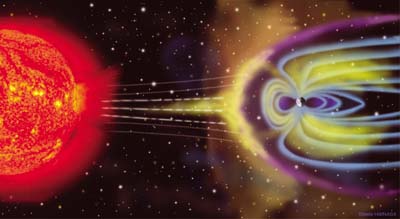 |
 |
| CURRENT ISSUE |  |
PAST ISSUES |  |
SEND A LETTER/NEWS |  |
ADDRESS UPDATE |  |
ADVERTISE |  |
ABOUT US |  |
ALUMNI HOME |
Features

Here Comes the Sun
UNH scientists are unraveling the mysteries of solar storms.
First, the weather: Solar activity is at low-to-moderate levels, although one large sunspot group could generate some medium-sized flares. Two masses of plasma have erupted from the sun, but they're not headed our way. While geomagnetic-field activity is a little unsettled due to high-speed particles from a big coronal hole, the probability of a severe geomagnetic storm is just about zilch. And hey, here's some good news: none of the 452 known asteroids that could conceivably hit our planet are currently on a collision course.
No, that doesn't sound like the weather report you heard on the radio this morning, but it is the kind of information issued every day by the National Oceanic and Atmospheric Administration's Space Environment Center. The SEC monitors conditions in the environment between the sun and Earth, collecting and analyzing data received from a large number of ground-based observatories and orbiting satellites. A lot of that data is collected by instruments designed and built at the University of New Hampshire.
It might sound odd to talk about "the environment between the sun and Earth." It's just empty space out there, right? Not really. The apparent void beyond Earth's atmosphere is actually full of charged particles (plasma) continuously streaming from the sun in the solar wind. These particles, moving at about a million miles per hour, constantly buffet Earth's magnetic envelope, which provides an extremely effective shield.
When strong surges in the solar wind hit the magnetosphere, they generate an electric current that flows from pole to pole, which we see as the aurora. These disturbances, often called geo-magnetic storms, can cause serious problems on Earth. In 1989, for example, a geomagnetic storm induced power surges in electrical transmission lines in Quebec, tripping circuit breakers and plunging the entire province into darkness for nine hours. Storms in 1994 and 1997 knocked out three communications satellites, which had to be replaced at a cost of about $200 million each. Geomagnetic storms also block high-frequency radio transmissions for days at a time and interfere with high-tech navigation systems on planes and ships.
Fortunately, major geomagnetic storms are relatively rare events. NOAA estimates that some 2,600 storms occur in an average 11-year solar cycle, but we don't even notice most of them. Only a few--about four in each solar cycle--are serious enough to be labeled "extreme," the highest ranking on NOAA's five-level scale.
Scientists have become much better at forecasting those extreme events in recent years. A number of research satellites launched since 1994 (including six carrying instruments designed at UNH) have given forecasters better tools to monitor solar activity. They have provided a wealth of new information about the sun, and they serve as a kind of early-warning system when major solar disturbances occur.
Page: 1 2 3 4 Next >Easy to print version
blog comments powered by Disqus
